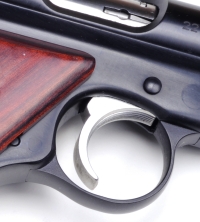 I bought a pair of .22 semi-auto pistols a while back and I'm just now realizing how good that decision was. The one at bottom was my first choice, a Smith & Wesson 22A-1, and while I was in the gun shop I spotted the one at top, a
I bought a pair of .22 semi-auto pistols a while back and I'm just now realizing how good that decision was. The one at bottom was my first choice, a Smith & Wesson 22A-1, and while I was in the gun shop I spotted the one at top, aColt Huntsman.
I thought about that little Colt for a day or two and decided I had to have it too. I had a Navy buddy, lo many years ago, who had a Colt Woodsman which has got to the greatest shooting .22 I ever laid hands on. Buying a Colt Woodsman today is generally reserved for Colt collectors who have a heck of a lot more money than I do. But the Huntsman is the budget version of the Woodsman and this one was only $300, which is a real bargain. So I went back to the shop and bought it, too.
Turned out they were both great shooting pistols, but the S&W has the edge over the 30+year-old Colt. The proof, as with almost all guns, is in the trigger. Both had great triggers, but the Smith was the best. It measures with my Lyman Digital Trigger Gauge, at 1 lb. 12.4 oz., while the Colt measured at 2 lbs. 3.9 oz. And I speak about the Colt in the past tense because I bought it for $300 and then sold it two weeks later for $375 after deciding I didn't need two .22 pistols.
I used the cash and a little extra to buy a brand new in box S&W 21-4 .44 Special, the Clint Smith Thunder Ranch version revived by S&W as the start of their current Classic series. I bought it the highway robbery price of $425. I shoulda been arrested for taking advantage of a gun dealer.
 |
| S&W Model 21-4, 4" barrel, blue steel with factory Rosewood grips. |
And though I may still get a Buck Mark one of these days, I have learned something about the Ruger Mk. IIIs that makes me mark them off my list permanently. They have terrible triggers.
The recent newsletter from Brownell's (the greatest source of gun parts and accessories in the free world) had a gunsmith's article about how to install a decent trigger in a Ruger Mk. III.

The trigger was probably the only real shortfall. It had a good deal of take up or pretravel, there was a considerable amount of creep before it broke heavily, then there was significant overtravel. Additionally, the Ruger's trigger pivot is located far forward of the trigger's vertical centerline, causing the trigger to move upward in a tight arc as it was pulled. I like the parallel pull of a 1911 trigger or other designs that place the pivot over the trigger centerline. Pull was a heavy 4¼ - 4 ¾ lbs.
Between the upward arc of the trigger, its long pull and overtravel, I found myself pulling shots to the right. Groups spread horizontally as the pressure exerted on the trigger was directed above the plane formed at the web of my hand. I liked the gun, but the trigger had to go.
If you're mechanically inclined, or have a good gunsmith to go to, go get yourself a Ruger Mk. III. The Brownell's article tells you how to fix that bad trigger. As for me, I'll just hang with Smiths.

No comments:
Post a Comment